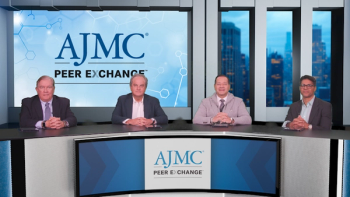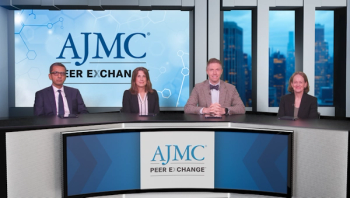
Experts discuss dose reduction strategies and emerging therapies for desmoid tumors, emphasizing patient monitoring and quality of life improvements.

Experts discuss dose reduction strategies and emerging therapies for desmoid tumors, emphasizing patient monitoring and quality of life improvements.

Ryan Haumschild, PharmD, MS, MBA, introduces the faculty and sets the agenda to explore disease background, novel therapies, and operational considerations in relapsed/refractory multiple myeloma.

Panelists discuss how relapse intensifies clinical and economic burdens, reinforcing the need for adherence and prevention-focused care.

Panelists discuss how defining and tracking meaningful real-world outcomes ensures accountability and value in MASH management.

Ryan Haumschild, PharmD, MS, MBA, introduces the faculty and sets the agenda to explore disease background, novel therapies, and operational considerations in relapsed/refractory multiple myeloma.

Panelists discuss how early and sustained intervention can reshape schizophrenia’s chronic course and improve long-term quality of life.

Panelists discuss how long-term LDL-C exposure heightens cardiovascular risk, making early and sustained lowering crucial.

Andrew Zelenetz, MD, PhD, discusses the dual strategy of using the duration of benefit metric and re-biopsy to navigate complex sequencing decisions in targeted lymphoma therapy.

Nerandomilast's tolerability and dual antifibrotic/immunomodulatory mechanism directly address the critical non-adherence issue with current therapies, positioning it as a potential first-line treatment for IPF and PPF despite remaining questions about very long-term efficacy and the need for biomarkers.

Nerandomilast, a novel anti-fibrotic agent with improved tolerability and a dual antifibrotic/immunomodulatory mechanism, showed sustained efficacy in the FIBRONEER trials for IPF and PPF, achieving FDA approval for IPF in October 2025.

Panelists discuss how improving adherence to LDL-lowering therapies is essential for sustained cardiovascular protection.

The NCCN guidance transitioned from a specific focus on rituximab to a broad, future-proof policy covering all FDA-approved biosimilars, which simplifies treatment decisions and promotes patient access.

Four years of long-term data confirm the continued safety of the drug tildrakizumab in patients with psoriatic arthritis.

FDA approval of Nirogacistat for desmoid tumors highlights improved survival rates, quality of life, and manageable side effects for patients.

Zachary Contreras of Sharp Health Plan discusses how predictive tools, artificial intelligence-driven analytics, and digital monitoring can help identify treatment-resistant depression early, enabling timely intervention with dextromethorphan-bupropion and reducing clinical and economic burden.

Explore the evolving landscape of desmoid tumor treatments, including chemotherapy, tyrosine kinase inhibitors, and emerging clinical trials.

Zachary Contreras of Sharp Health Plan discusses how dextromethorphan-bupropion may improve agitation management in Alzheimer disease while reducing healthcare costs and supporting patient-centered care.

Panelists discuss how stigma and symptom overlap delay accurate schizophrenia diagnosis and how early intervention can transform outcomes.

Panelists discuss how multidisciplinary collaboration is essential for preventing progression and improving outcomes in MASH care.

Ryan Haumschild, PharmD, MS, MBA, introduces the faculty and sets the agenda to explore disease background, novel therapies, and operational considerations in relapsed/refractory multiple myeloma.

Ryan Haumschild, PharmD, MS, MBA, introduces the faculty and sets the agenda to explore disease background, novel therapies, and operational considerations in relapsed/refractory multiple myeloma.

Panelists discuss how noninvasive risk assessments enable early detection and targeted management of fibrosis in MASH patients.

Panelists discuss how genetics, environment, and substance use interplay to shape schizophrenia risk and guide preventive care.

Andrew Zelenetz, MD, PhD, discusses how patient characteristics and disease history play into treatment strategy for follicular lymphoma.

Panelists discuss how payer controls and prior authorization policies delay and derail LDL-lowering therapy.

Panelists discuss how PCSK9 inhibitors remain underused due to access, cost, and adherence barriers.

Andrew Zelenetz, MD, PhD, addresses the potential for CD19 antigen loss, the lack of robust data, and the influence of newer, highly efficacious combination therapies on the sequencing decisions in follicular lymphoma.

Panelists discuss how patients express satisfaction with digital therapeutics for their convenience and real-time accessibility, though lack of payer coverage limits the ability to gather meaningful real-world evidence on their effectiveness.

Panelists discuss how CT-155, a 16-week interactive digital application, met its primary end point in clinical trials by successfully improving experiential symptoms of schizophrenia compared with a control app, with an excellent safety profile.

Explore the evolving landscape of desmoid tumor treatments, highlighting surgery, cryotherapy, and radiotherapy for effective patient care.

259 Prospect Plains Rd, Bldg H
Cranbury, NJ 08512
© 2025 MJH Life Sciences®
All rights reserved.
